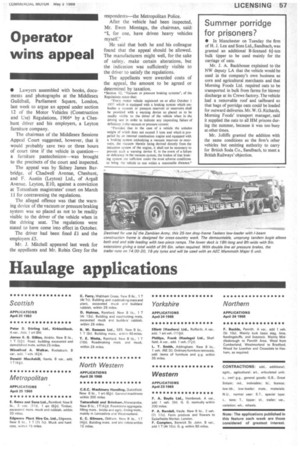Operator wins appeal
Page 59

If you've noticed an error in this article please click here to report it so we can fix it.
• Lawyers assembled with books, documents and photographs at the Middlesex Guildhall, Parliament Square, London, last week to argue an appeal under section 12 of the Motor Vehicles (Construction and Use) Regulations, 1966* by a Cheshunt driver and his employers, a Leyton furniture company.
The chairman of the Middlesex Sessions Appeal Court suggested, however, that it would probably save two or three hours of court time if the vehicle in question—
a furniture pantechnicon was brought to the precincts of the court and inspected.
The appeal was by Sidney James Burbridge, of Chadwell Avenue, Cheshunt, and F. Austin (Leyton) Ltd., of Argun Avenue. Leyton, E10, against a conviction at Tottenham magistrates' court on March 11 for contravening the regulations.
The alleged offence was that the warning device of the vacuum or pressure braking system was so placed as not to be readily visible to the driver of the vehicle when in the driving seat. The regulations were stated to have come into effect in October.
The driver had been fined LI and the employers £5.
Mr. J. Mitchell appeared last week for the appellants and Mr. Robin Grey for the respondents—the Metropolitan Police.
After the vehicle had been inspected, Mr. Ewen Montagu, the chairman, said: "I, for one, have driven heavy vehicles myself."
He said that both he and his colleague found that the appeal should be allowed. The manufacturers might well, for the sake of safety, make certain alterations, but the indication was sufficiently visible to the driver to satisfy the regulations.
The appellants were awarded costs . of the appeal, the amount to be agreed or determined by taxation,
*Section I?, -Vacuum or pressure braking systems", of the Regulations states that: "Every motor vehicle registered on or after October 1 1937 which is equipped with a braking system which embodies a vacuum or pressure reservoir or reservoirs shall be provided with a warning device so placed as to be readily visible to the driver of the vehicle when in the driving seat in order to indicate any impending failure of deficiency in the vacuum or pressure system: "Provided that in the case of a vehicle the unladen weight of which does not exceed 3 tons and which is propelled by an internal combustion engine and equipped with a braking system embodying a vacuum reservoir or reservoirs, the vacuum therein being derived directly from the induction system of the engine, it shall not be necessary to provide such a warning device if, in the event of a failure or deficiency in the vacuum system, the brakes of that braking system are sufficient under the most adverse conditions to brine the vehicle to rest within a reasonable distance."




































































































































































































































